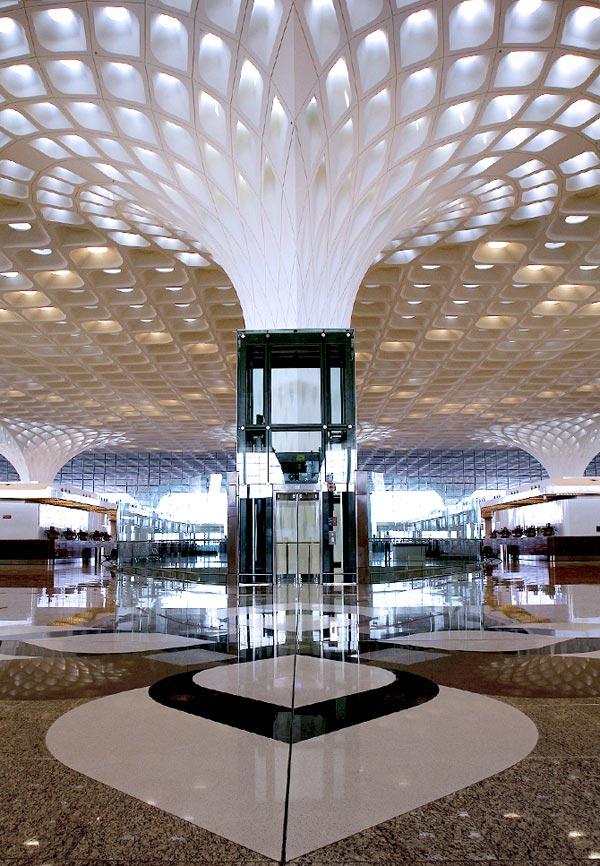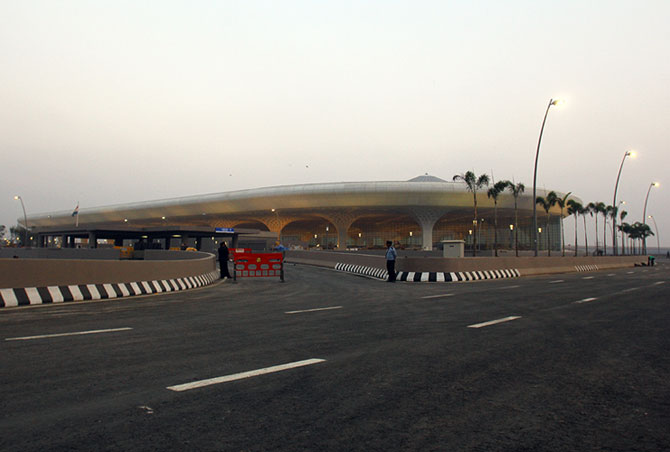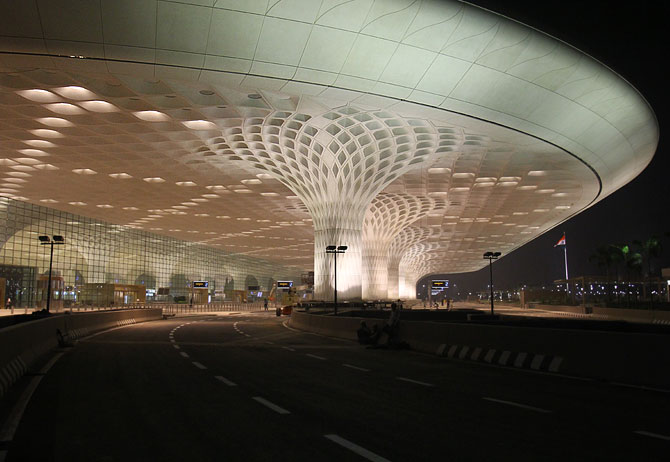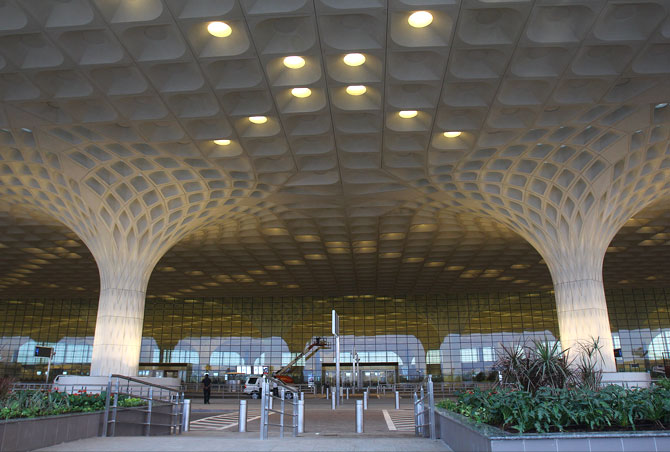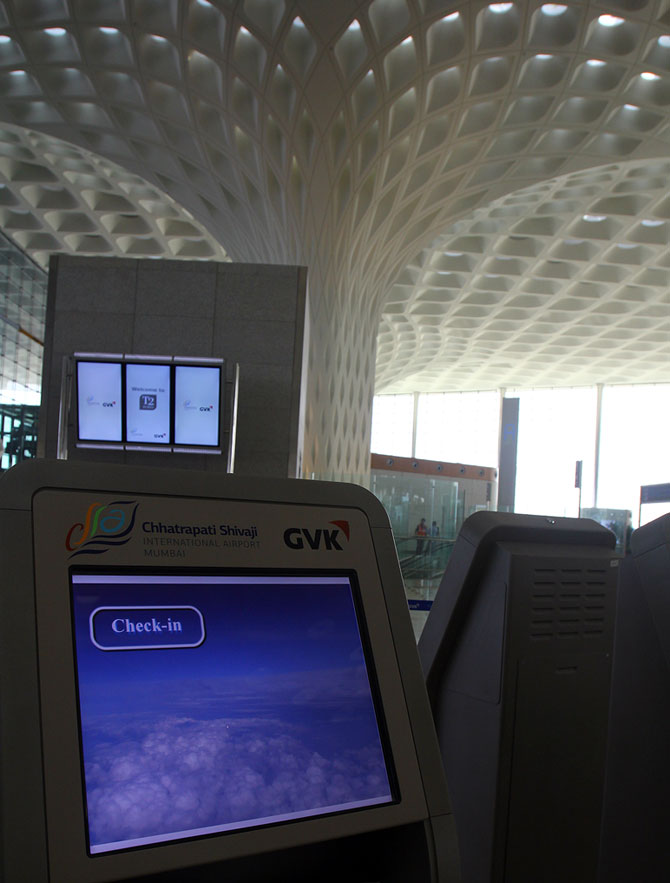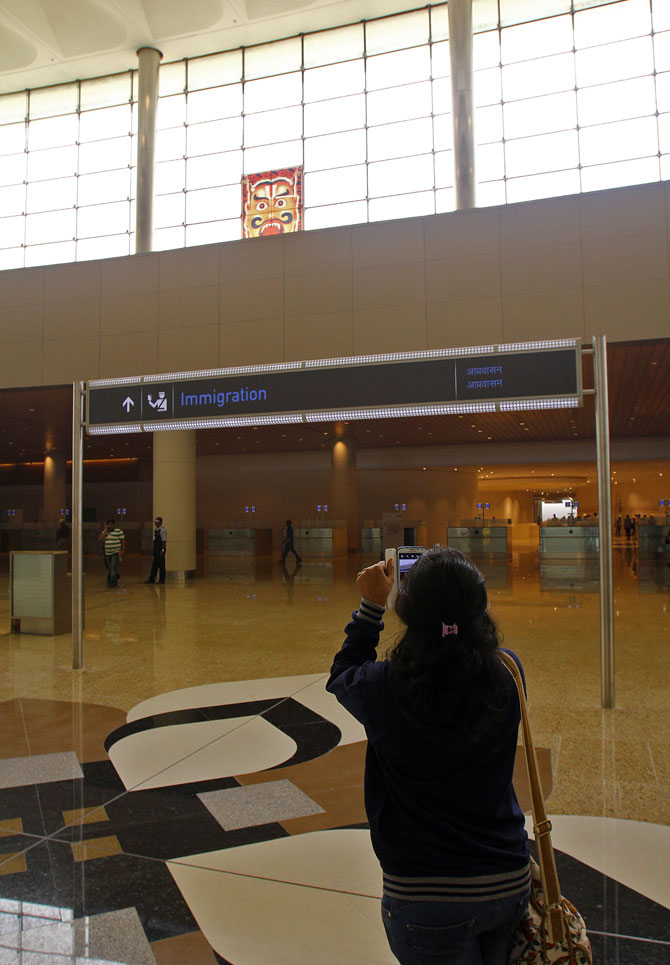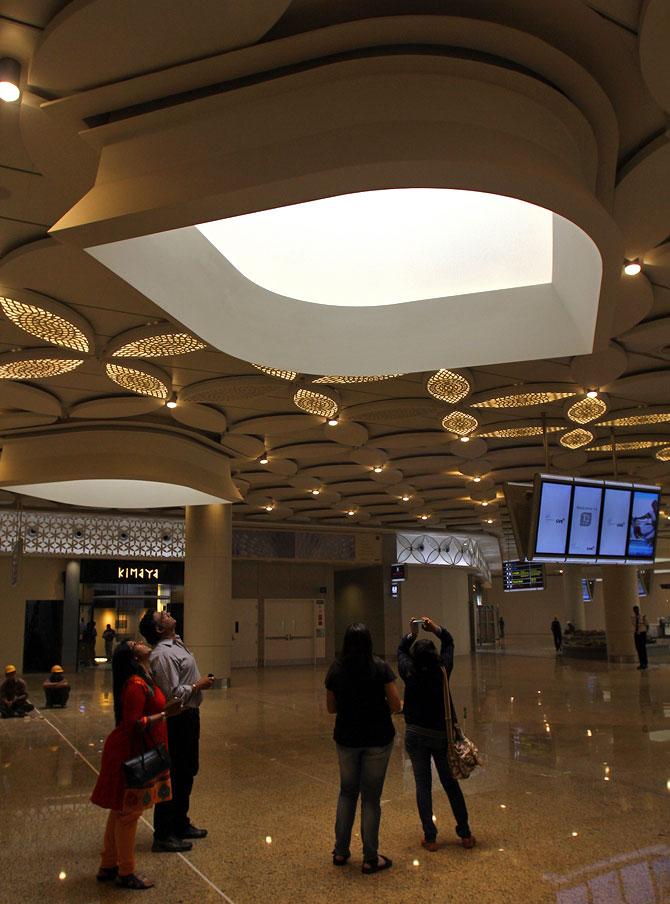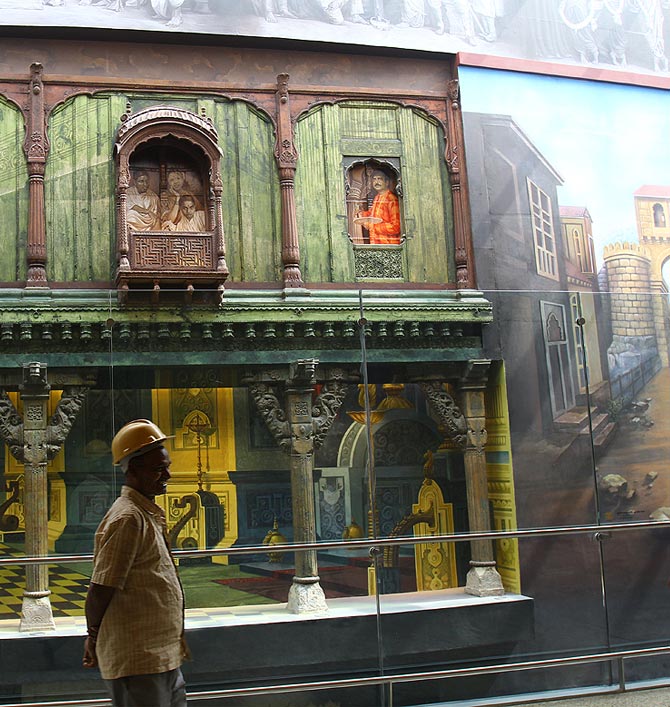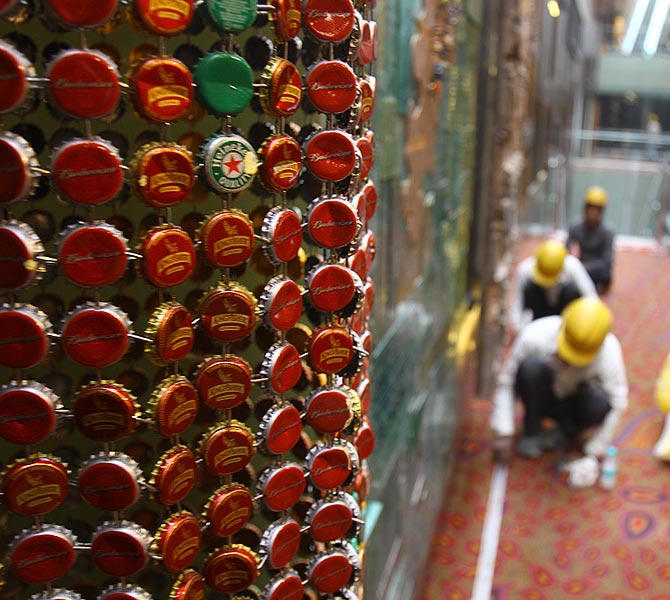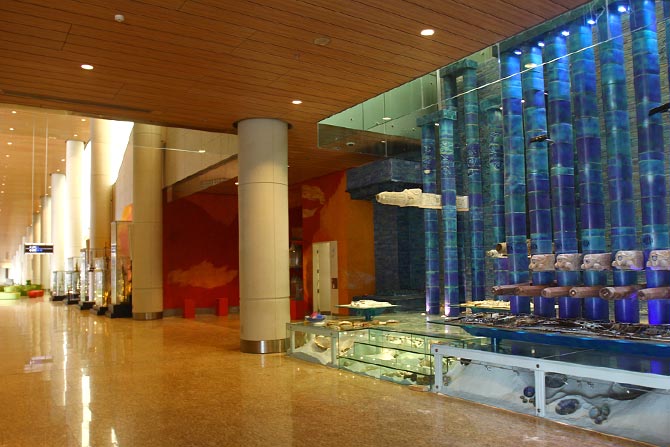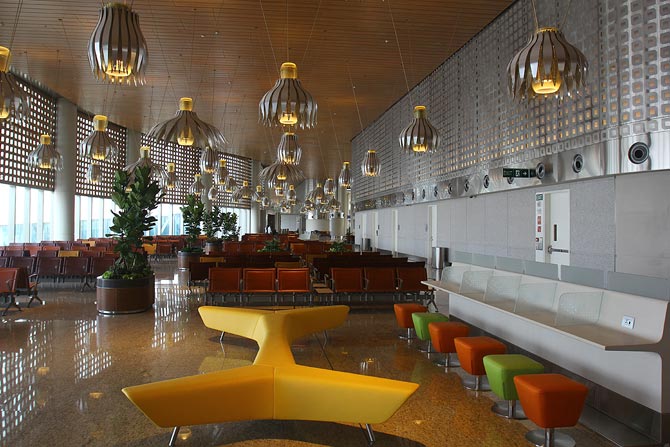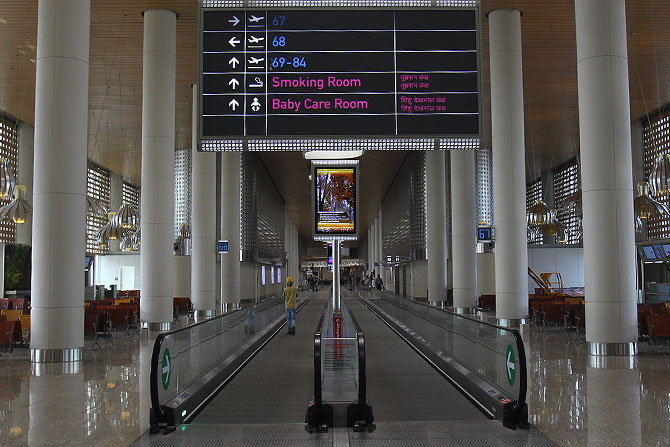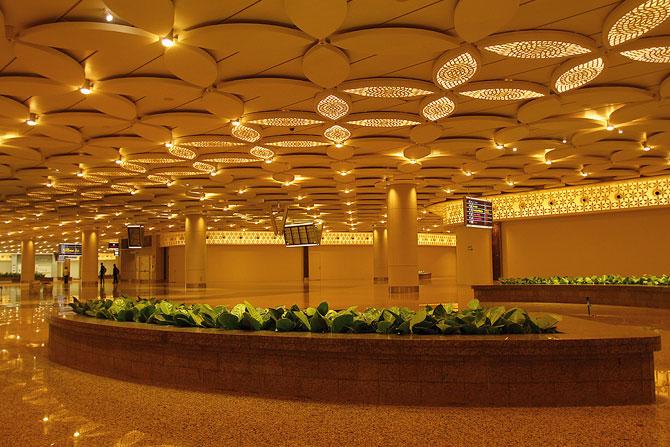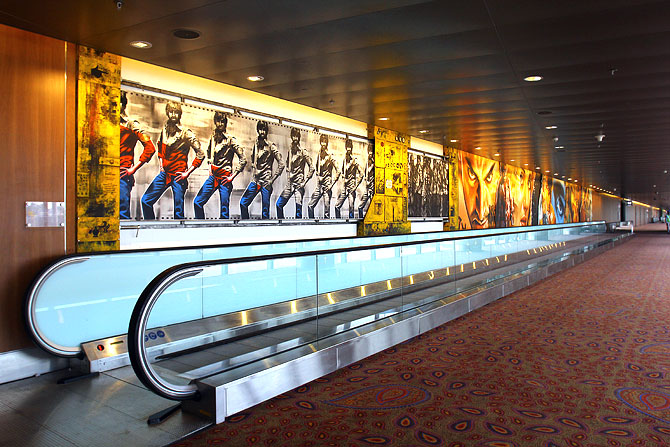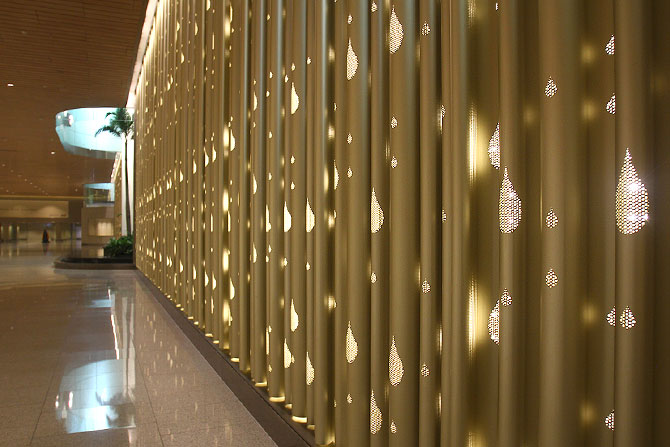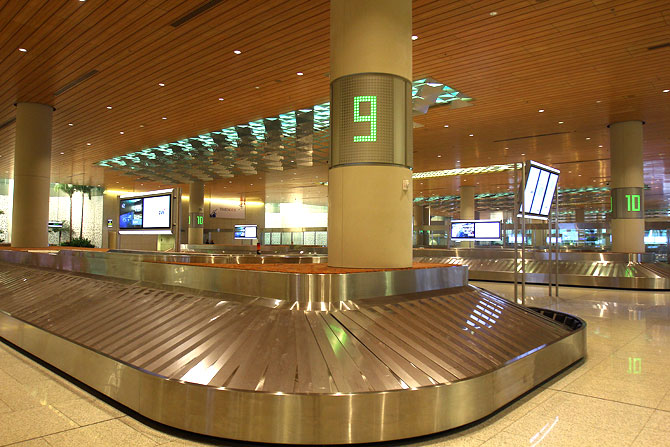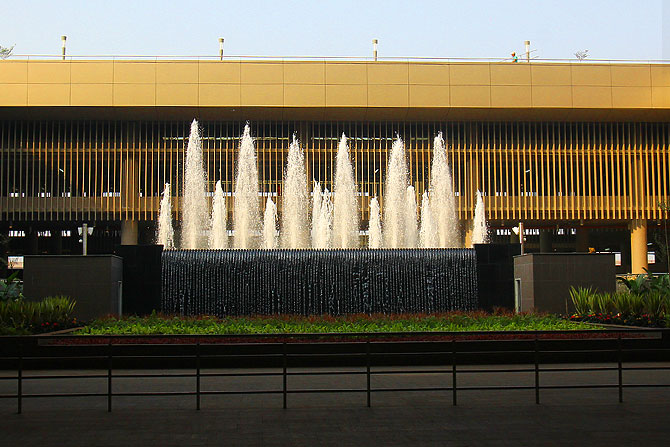 | « Back to article | Print this article |
EXCLUSIVE images: INSIDE Mumbai's NEW airport terminal, T2
Rajesh Karkera, who was allowed exclusive access to Mumbai’s new airport terminal, T2, tells its story in pictures.
Mumbai’s fliers have a cause to rejoice in their international airport’s new terminal, T2, which was inaugurated by Prime Minister Manmohan Singh last week. The upgraded terminal, which will be thrown open to the public on February 12, cost Rs 55 billion and will handle 40 million passengers a year, up from the current 10 million.
Anand Mahindra, among India’s most respected industrialists, had this to say about the city’s new airport terminal, on Twitter: ‘After a supercharged Sunday tour of Mumbai's T2.I say, confidently, that in comparison. EVERY other airport in the world seems banal & bland… T2 is one airport which I wouldn't mind being stranded in-like Tom Hanks in 'The Terminal!'
Rediff.com’s Rajesh Karkera, who was allowed exclusive access into the sprawling terminal building, where workers were busy putting the finishing touches, brings us these photographs.
Please click on NEXT to read more...
EXCLUSIVE images: INSIDE Mumbai's NEW airport terminal, T2
Every-time I flew to Delhi’s swanky T3 terminal, I’d send out a silent prayer: Why oh why can’t Mumbai have a similar facility? Why are we, despite being the country’s financial capital, stuck with an inadequate airport in Sahar? When will deliverance come and I can cock a snook at the uppity Delhi-ites?
After being allowed into Mumbai’s brand new T2 terminal, I am happy to say that my prayers have been answered. More than answered, as the relief in fact starts before you reach the airport.
For all those countless fliers who have struggled through Mumbai traffic to get to the Sahar airport (Chhatrapati Shivaji International Airport, to give its full name), the new access points will come as a big relief.
Because, making the commute easier is an elevated road that lifts you off the Western Expressway traffic, right from Santacruz itself, if you are coming from South Mumbai. Time taken from here to the terminal: five minutes.
For those driving in from the northern suburbs, ie, beyond Andheri, there’s a new ramp immediately after the Hyatt Regency hotel. Why not before, you ask? Because this part of the town has a hurdle called the Mumbai Metro, that’s why!
Please click on NEXT to read more...
EXCLUSIVE images: INSIDE Mumbai's NEW airport terminal, T2
Approach the departure gates and you are greeted by giant pillars, engraved with the peacock feather motif, extending towards the roof and increasing in size. Some 30 of these massive pillars hold up the terminal’s 11-acre roof which has 30,000 sq ft of skylight that supply ample natural light inside.
Chicago-based architects Skidmore, Owings & Merrill, were in fact inspired by India’s national bird in designing T2. Little wonder, the new terminal has already been dubbed the new Peacock Throne.
Please click on NEXT to read more...
EXCLUSIVE images: INSIDE Mumbai's NEW airport terminal, T2
Look towards the terminal and you can see almost the whole check-in area from the outside. This makes saying goodbye to your near and dear ones better as they depart.
Enter, and you are again greeted by the massive pillars standing guard over the 188 check-in counters where you need to head. GVK, developers of the airport, has assured that business class passengers will have a maximum wait time of five minutes, while for economy passengers it will be 20 minutes.
Please click on NEXT to read further...
EXCLUSIVE images: INSIDE Mumbai's NEW airport terminal, T2
For those who love DIY, there are 20 self check-in kiosks as well. The baggage carousels are positioned at an angle, which I was later told have been placed thus so that the baggage contents are not disturbed as they trundle out.
Please click on NEXT to read more...
EXCLUSIVE images: INSIDE Mumbai's NEW airport terminal, T2
One nit to pick. The self check-in kiosks, although there, are not very distinguishable. It took one of the GVK guys to tell me that they were there -- right under my nose! My bad -- I was actually looking for a sign saying 'Self check-in kiosks'.
Please click on NEXT to read further...
EXCLUSIVE images: INSIDE Mumbai's NEW airport terminal, T2
Beyond the check-in counters is the security check area and up ahead one cannot miss the huge immigration area with 60 counters. What I do hope for is that when the terminal opens on February 12 for international passengers (domestic fliers will have to wait till next year to access T2), each of these counters is manned even if there is only one passenger waiting in line. Otherwise there’s no sense in having so many counters, is there?
Also, I could not but help notice images of the demon face that trucks often sport to ward off the bad luck, all over the airport. Looks a tad out-of-place in this state-of-the-art place, if you ask me.
Please click on NEXT to read further...
EXCLUSIVE images: INSIDE Mumbai's NEW airport terminal, T2
Immediately after the immigration area is the duty-free shopping zone and eateries. The duty-free space seems somewhat smaller in size compared to the current airport but the accessibility is almost immediate, you just cannot miss it.
Immediately after the duty-free area is the retail shopping area, spread over 226,000 square feet. And when you are hungry after all that shopping, you can sate yourself at the Pizza Hut, Domino’s, KFC and other outlets.
Please click on NEXT to read further...
EXCLUSIVE images: INSIDE Mumbai's NEW airport terminal, T2
Pass the shopping area, and just before you head to either the lounge or your departure gate you will come across a large wall which is more like a huge art facility, showcasing art from every region of India.
Titled ‘Jaya He’, the art walk is spread over 80,000 square feet, can be seen from all four levels, and features works done by Indian artists as well as some foreign ones. The execution of the ambitious project was given to the Asian Heritage Foundation, and most of the work has been done in time for the public inauguration a month away.
At 3.2 km long, it is billed as the world’s largest public art exposition, and features around 7000 works.
Please click on NEXT to read more...
EXCLUSIVE images: INSIDE Mumbai's NEW airport terminal, T2
It’s not all traditional stuff, though, at the art wall. Among the pieces that caught my eye was an artwork by multimedia artist Akshay Rajpurkar, titled Mumbai Google Map. Created using recycled material like computer circuit boards, it is a map of Mumbai with resisters and condensors shaped as buildings. There was another artwork made of bottle caps.
When the whole thing is ready, visitors can know about each artwork by pointing their cellphones at the signature on it and see all the data about it, like its history, theme etc. However, this Complex Asset Resource Management or CARM is not yet ready.
Please click on NEXT to read more...
EXCLUSIVE images: INSIDE Mumbai's NEW airport terminal, T2
One of the art installations is interactive, and is part of the Panch Mahabhuta series. The idea of film director Shekhar Kapur, it was designed by the Asian Heritage Foundation’s chairman Rajeev Sethi, and is a collaboration among artist Ashish Tyagi, BR Pandit, Vipul Kumar, Priya Sundaravalli and KJ Singh. If you’ve been to New York, you will find it somewhat similar to the ones in the subways, where you place your hand over an air vent and it makes a sound. Here you place your hand over the flow of water and it creates a sound, each of the flows producing a different note. So you make music as you play with the flow of water.
Please click on NEXT to read more...
EXCLUSIVE images: INSIDE Mumbai's NEW airport terminal, T2
It’s a long walk to the departure gates and if you feel the need to sit and rest your feet there are different sitting areas spread across the sides of the terminal. What keeps them similar are the lotus-shaped chandeliers, which can be opened fully like a lotus in full bloom, or kept closed like a bud. I am glad to note that there are ample charging points, too. Also on offer is free wifi.
Please click on NEXT to read more...
EXCLUSIVE images: INSIDE Mumbai's NEW airport terminal, T2
The approach to the departure gates has ample walkalators, something we haven't really seen much of in Mumbai. Certainly not in the old terminal. Good idea, we say, considering the length one has to cover on foot.
Please click on NEXT to read more...
EXCLUSIVE images: INSIDE Mumbai's NEW airport terminal, T2
Like any public facility, an airport too rises and falls by the quality of its restrooms. Spread evenly across the airport are ample restrooms which are basic and quite user-friendly.
Another nit to pick. The toilet paper doesn’t roll out easily from the dispenser and needs an effort to be extricated. This may be because the overenthusiastic workers filled up the roll to the brim, maybe they need to work on that. Not really user-friendly, if you are running late to board!
Please click on NEXT to read more...
EXCLUSIVE images: INSIDE Mumbai's NEW airport terminal, T2
GVK, which started work on the upgrade only in 2011, had to battle encroachments on the land as well space constraints in land-locked Mumbai. Hence the four-level structure, as like in the rest of the city it is easier to go vertical.
In the present scheme of things level 4 is for international departures, while level 3 is for domestic passengers. Level 2 is for arrivals, and level 1 is the exit area.
Please click on NEXT to read more...
EXCLUSIVE images: INSIDE Mumbai's NEW airport terminal, T2
In the arrivals area you are greeted by walkalators immediately after the aircraft ramp, and artworks from Bollywood to city streets. The peacock feather motif is carried across the terminal, right down to the carpet.
Please click on NEXT to read more...
EXCLUSIVE images: INSIDE Mumbai's NEW airport terminal, T2
The immigration area, which houses 72 counters, promises quick dispersal of passengers and, with a metal curtain with a 1000-diya motif adorning one wall, is a treat for the eyes as you await your turn.
Please click on NEXT to read more...
EXCLUSIVE images: INSIDE Mumbai's NEW airport terminal, T2
Exit to the baggage claims area is almost right after the immigration counters, with a small duty-free area similar in size to the one in the current terminal which one has to pass through. There are 10 baggage carousels which look much better than the current black rubber carousel in the old terminal.
Please click on NEXT to read more...
EXCLUSIVE images: INSIDE Mumbai's NEW airport terminal, T2
Coming out of the airport your first sight of Mumbai is of the water fountain right ahead in the centre. Now if only the rest of your intra-city journey was as pleasant…
